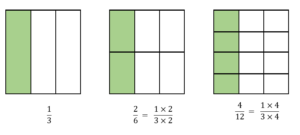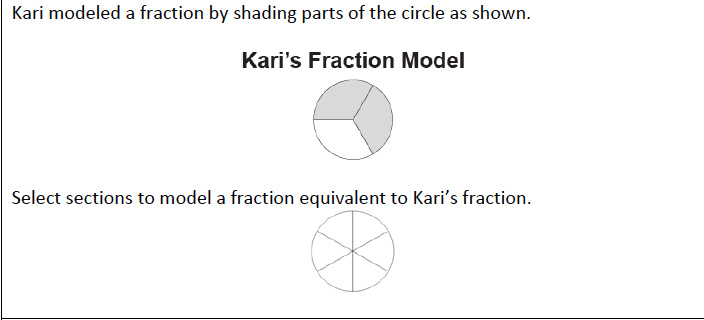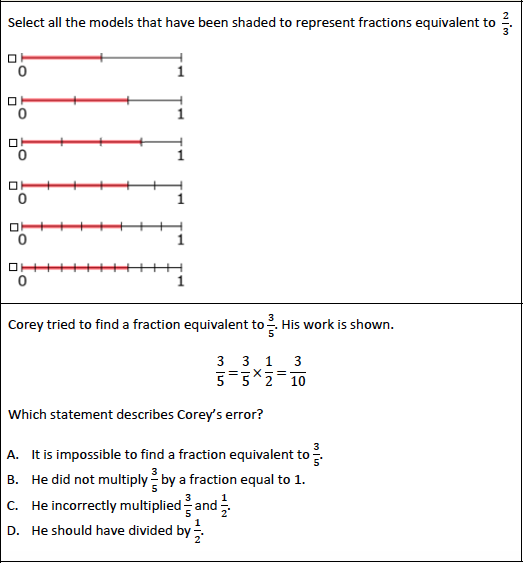Explain why a fraction a/b is equivalent to a fraction (n × a)/(n × b) by using visual fraction models, with attention to how the number and size of the parts differ even though the two fractions themselves are the same size. Use this principle to recognize and generate equivalent fractions.
[divider] [/divider]
Fraction Progressions Across Grade Levels
[divider] [/divider] Students are able to…
- Connect models of equivalent fractions to numerical representations.
- Create a rule for finding equivalent fractions and follow that rule.
- Identify equivalent fractions.
[divider] [/divider] Students are able to…because teachers…
- Provide students with tools and manipulatives to build sets of equivalent fractions and then write the fractions as numerals.
- Facilitate mathematical discussion about patterns in sets of equivalent fractions.
- Provide opportunities for students to build models and write numerals to generate a rule for finding equivalent fractions.
- Provide opportunities for students to build and identify equivalent fractions.
[divider] [/divider] Questions to ask students:
- How can you prove two fractions are equivalent using a model?
- Sample answer that indicates understanding:
Example below shows one way a student could show how two fractions are equivalent using a model. 4/5 can be split to show the equivalent fraction 8/10.
- Sample answer that indicates an incomplete understanding or a misconception: Student may not create two equal sized models or creates a different model that may not clearly show the relationship between the two fractions.
- What is the relationship between the denominators of the two equivalent fractions? What about the numerators?
-
- Sample answer that indicates understanding: The student should be able to explain that when the number of pieces in the whole (denominator) doubled from 5 to 10, the number of pieces being counted (numerator) also doubled. Thus, create equivalent fractions.
- Sample answer that indicates an incomplete understanding or a misconception: Student may not recognize the numerator and denominator are both doubled or does not make the connection with why that generates equivalent fractions.
- You stated that 1/2 and 2/4 are equivalent. Are there any other fractions equivalent to those??
- Sample answer that indicates understanding: Yes, I could double both the numerator and denominator or I can multiple both the numerator and the denominator by the same number.
- Sample answer that indicates an incomplete understanding or a misconception: Students may try to add the same number to both the numerator or the denominator. i.e 2/4 = 4/6
[divider] [/divider] FSA Notes
Cognitive Complexity Level: 3: Strategic Thinking & Complex Reasoning
Achievement Level Descriptors:
2- uses visual fraction models to recognize equivalent fractions by partitioning unit fraction pieces into smaller equal pieces
3- uses visual fraction models to generate and explain equivalent fractions by partitioning unit fraction pieces into smaller pieces (and understands that this is the same); generates and explains why fraction a/b is equivalent to a fraction (n x a)/(n x b), and multiplies by 1 represented as a fraction
4- uses a variety of strategies to generate and justify why fraction a/b is equivalent to a fraction (n x a)/(n x b)
5- [intentionally left blank]
Assessment Limits:
Denominators of given fractions are limited to: 2, 3, 4, 5, 6, 8, 10, 12, 100.
For items with denominators of 10 and 100, focus may not be on equivalence between these 2 denominators, since this is addressed specifically in standards MAFS.4.NF.5 – 7, but should focus on equivalence between fractions with denominators of 2, 4, and 5, and fractions with denominators of 10 and 100.
Fractions must refer to the same whole, including in models.
Fraction models are limited to number lines, rectangles, squares, and circles.
Fractions can be fractions greater than 1 and students may not be guided to put fractions in lowest terms or to simplify.
Equivalent fractions also include fractions .
[divider] [/divider] Additional Resources:
Additional in depth content knowledge
Blog Post: Proving equivalent fractions with models
Video: Equivalent fraction models
[divider] [/divider] Sample Formative Assessment Tasks:
[divider] [/divider] Resources/Tasks to Support Your Child at Home:
Give your child a fraction like 1/3 or 3/8 and ask them to list five fractions equivalent to it.
Find a fraction equivalent to 2/5 that has a denominator of 20.
Watch the Learnzillion video, “Understand and explain equivalent fractions…” – https://goo.gl/BrzlN1
Watch the Khan Academy video, “Intro to Equivalent Fractions” – https://goo.gl/A2CQfT
Play Equivalent Fraction Bingo. http://www.abcya.com/equivalent_fractions_bingo.htm
Give your child a fraction and have them name an equivalent fraction and then prove it with a model or number line.
Watch the LearnZillion video, “Make Equivalent Fractions Using Multiplication” – https://goo.gl/TRMtus
Play an equivalent fraction matching game. https://goo.gl/cZVfhf
Prove equivalent fractions using different models. http://illuminations.nctm.org/Activity.aspx?id=3510




